Washington University in St. Louis
It has been suggested that George Warren Brown School of Social Work be merged into this article. (Discuss) Proposed since April 2024. |
ASN 2552 | | |
Washington University in St. Louis (WashU) is a private research university in St. Louis, Missouri, United States. Founded in 1853, the university is named after George Washington, the first president of the United States.
Washington University comprises eight undergraduate, graduate, and professional schools, including Arts and Sciences, George Warren Brown School of Social Work, Olin Business School, Washington University School of Medicine, McKelvey School of Engineering, Washington University School of Law, School of Continuing & Professional Studies, and Sam Fox School of Design & Visual Arts. Washington University enrolls approximately 16,550 students across its campuses from all 50 states and more than 110 countries.
Washington University has been a member of the Association of American Universities since 1923 and is classified among "R1: Doctoral Universities – Very high research activity".[8][9] In 2021, the National Science Foundation ranked Washington University 25th among academic institutions in the United States for research and development expenditures.[10][11] The university's athletic teams, Washington University Bears, play in NCAA Division III as a founding member of the University Athletic Association.
As of 2023, 26 Nobel laureates, 11 Pulitzer Prize winners, 4 United States Poet Laureates, and 6 MacArthur Fellows have been affiliated with the university as faculty or alumni.[12][13] Washington University alumni also include 16 university presidents, 21 members of the United States Congress, 30 Rhodes Scholars, 7 Marshall Scholars and 2 Churchill Scholars.[14][15][16]
History
19th century


Washington University was conceived by 17
The university's first chancellor was Joseph Gibson Hoyt. Crow secured the university charter from the Missouri General Assembly in 1853, and Eliot was named president of the board of trustees. Early on, Eliot solicited support from members of the local business community, including John O'Fallon, but Eliot failed to secure a permanent endowment. Washington University is unusual among major American universities in not having had a prior financial endowment. The institution had no backing of a religious organization, single wealthy patron, or earmarked government support. To this day, Washington University is controlled by a board of trustees that, by charter, appoints its own members.[18]
During the three years following its inception, the university had three different names. The board first approved "Eliot Seminary", but William Eliot was uncomfortable with naming a university after himself and objected to the establishment of a seminary which would implicitly be charged with teaching a religious faith. He favored a nonsectarian university.[19]
Under pressure from Eliot, the board of trustees created a task force charged with naming the university, headed by Samuel Treat. Several months later Treat's committee proposed naming the university the Washington Institute, after the nation's first president George Washington. In 1854, the board of trustees changed the name to "Washington Institute" in honor of George Washington and because the charter was coincidentally passed on Washington's birthday, February 22.[20] Naming the university after the nation's first president, only seven years before the American Civil War and during a time of bitter national division, was no coincidence. During this time of conflict, Americans universally admired George Washington as the father of the United States and a symbol of national unity. The board believed that the university should be a force of unity in a strongly divided Missouri. In 1856, the university amended its name to "Washington University".
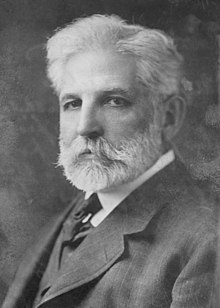
Although chartered as a university, for many years Washington University functioned primarily as a night school located on 17th Street and Washington Avenue in downtown St. Louis. Owing to limited financial resources, Washington University initially used public buildings. Classes began on October 22, 1854, at the Benton School building. At first the university paid for the evening classes, but as their popularity grew, their funding was transferred to the
In 1867, the university opened the first private nonsectarian law school west of the Mississippi River. By 1882, Washington University had expanded to numerous departments, which were housed in various buildings across St. Louis. Medical classes were first held at Washington University in 1891 after the St. Louis Medical College decided to affiliate with the university, establishing the School of Medicine. However, by the 1890s the university was on the brink of financial collapse until Robert Sommers Brookings, president of the board of trustees, undertook the task of rebuilding the university's finances and acquiring land for a new campus. Brookings was instrumental in raising money for the university, since Eliot, the primary fundraiser for the university, had died.
In 1896, Holmes Smith, professor of Drawing and History of Art, designed what would become the basis for the modern-day university seal. The seal is made up of elements from the Washington family coat of arms and the symbol of Louis IX, whom the city is named after.[22]
Washington University spent its first half century in downtown St. Louis bounded by Washington Ave., Lucas Place, and Locust Street. By the 1890s, owing to the dramatic expansion of the medical school and a new benefactor in Robert Brookings, the university began to move west. The university board of directors began a process to find suitable ground and hired the landscape architecture firm Olmsted, Olmsted & Eliot of Boston. A committee of Robert S. Brookings, Henry Ware Eliot, and William Huse found a site of 103 acres (41.7 ha) just beyond Forest Park, located west of the city limits in St. Louis County. The elevation of the land was thought to resemble the Acropolis and inspired the nickname of "Hilltop" campus, renamed the Danforth campus in 2006 to honor former chancellor William H. Danforth.[23]
In 1899, the university opened a national design contest for the new campus.
20th century

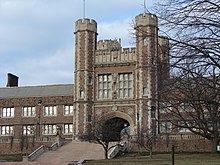
The cornerstone of the first building, Busch Hall, was laid on October 20, 1900. The construction of Brookings Hall, Ridgley, and Cupples began shortly thereafter.[26]
The university delayed occupying these buildings until 1905 to accommodate the
By 1915, construction of a new medical complex was completed on Kings Highway in what is now St. Louis's Central West End. In 1918, Washington University admitted its first women medical students.[27]
During
After working for 22 years at the University of Chicago, Compton returned to St. Louis in 1946 to serve as Washington University's ninth chancellor.[30] Compton reestablished the Washington University football team, making the declaration that athletics were to be henceforth played on a "strictly amateur" basis with no athletic scholarships. Under Compton's leadership, enrollment at the university grew dramatically, fueled primarily by World War II veterans' use of their GI Bill benefits.[31]
The desegregation of Washington University began in 1947 with the School of Medicine and the School of Social Work.[32] The university ended racial segregation in its undergraduate divisions in 1952, making it the last local higher education institution to do so. During the 1940s, the university faced criticism from the local African American media, which included a letter-writing campaign by churches, the local Urban League, and legal briefs by the NAACP, seeking to strip the university of its tax-exempt status.
In 1949, a student group, the Student Committee for the Admission of Negroes (SCAN), was founded and began advocating for full racial integration. In 1951, then-vice chancellor Leslie Buchan argued that full desegregation would isolate the university from the community and potentially lead to incidents on campus.[citation needed] The following year, in May 1952, the board of trustees passed a resolution desegregating the university's undergraduate divisions.[33]
During the latter half of the 20th century, Washington University transitioned from a commuter college to a world-renowned institution.[34] In 1957, planning began for the construction of the "South 40", a complex of modern residential halls which primarily house freshmen and some sophomore students.[35]
With additional on-campus housing, the university, which had been predominantly attended by commuter students, began attracting a greater number of applicants from across the nation.[36] By 1964, over two-thirds of incoming students came from outside the St. Louis area.[37]
In 1971, the board of trustees appointed Chancellor William Henry Danforth, who guided the university through the social and financial crises of the 1970s, strengthened the School of Medicine, and improved the often tense ties between the university and the St. Louis community. During his 24-year chancellorship, he established 70 new endowed professorships, constructed dozens of buildings, secured a $1.72 billion endowment, and tripled the amount of student scholarships.[34]
To better distinguish itself in national media, the university's board of trustees added the phrase "in St. Louis" in 1976.[38]
In 1995,

Washington University's reputation was enhanced by two major fundraising efforts since the 1980s. From 1983 to 1987, the "Alliance for Washington University" campaign raised $630.5 million, which was then the most successful fund-raising effort in national history.[41] From 1998 to 2004, the "Campaign for Washington University" raised $1.55 billion, which was applied to additional scholarships, professorships, and research initiatives.[42]
21st century
In 2002, Washington University co-founded the
In 2005, Washington University founded the McDonnell International Scholars Academy, an international network of premier research universities, with an initial endowment gift of $10 million from John F. McDonnell.[45][46] The academy, which selects scholars from 35 partnered universities around the world, was created to develop a cohort of future leaders, strengthen ties with top foreign universities, and promote global awareness and social responsibility.[47][48]
In Fall 2006, the
In June 2019,
In October 2021, Washington University announced it would invest an additional $1 billion in financial aid for students.[53] The university practices need-blind admissions and meets 100% of admitted students' demonstrated needs.[54] The new financial aid initiative, called Gateway to Success, included $800 million in endowed funding to support need-blind undergraduate admissions, meaning the university will not consider an applicant's financial situation when making admissions decisions while still meeting 100% of demonstrated financial need for admitted undergraduates.[55] Another $200 million will be designated for financial aid for graduate and professional students in the university's Brown School, the School of Law and the School of Medicine, as well as in business, engineering, art and architecture, and Arts & Sciences.[54]
In 2022, Washington University was one of 10 universities picked to join the Kessler Scholars Collaborative, which provides support for selected first-generation and Pell-Grant eligible STEM students.
In March 2024, Washington University agreed to purchase the campus of neighboring Fontbonne University when it closes in 2025.[59]
U.S. presidential and vice-presidential debates
Washington University has been selected by the
The campus was the venue for four Presidential debates, and one Vice-Presidential debate: the inaugural 1992 Presidential debate on October 11, 1992,[61] the third 2000 Presidential debate on October 17,[61] the second 2004 Presidential debate on October 8,[61] the sole 2008 Vice Presidential debate between Joe Biden and Sarah Palin on October 2,[62] and the second 2016 Presidential debate on October 9. The university was scheduled to host a debate in 1996, but that debate was cancelled when the number of scheduled debates was scaled back to two.[63][64]
Following the 2004 debate, Chancellor Wrighton initially expressed skepticism about hosting another debate but later changed his view.[65] He acknowledged the unique educational opportunities for students and emphasized the role of these events in contributing to a national understanding of important issues. Wrighton also highlighted their impact in bringing national and international attention to the St. Louis region, positioning it as one of America's great metropolitan areas.[66]
Contrary to the majority opinion of the student body, the university opted not to host a 2020 presidential debate.[67]
Campuses
Danforth
The university's 169-acre Danforth Campus is bordered by the Forest Park section of St. Louis and Clayton and University City, Missouri.

A large portion of the Danforth Campus is recognized as the Washington University Hilltop Campus Historic District, which achieved National Historic Landmark status on February 27, 1987.[68][69]
The Barry Flanagan bronze statue, "Thinker on a Rock," widely known, simply, as "The Bunny", is currently on permanent loan to Washington University and features prominently near Olin Library, Graham Chapel and Mallinckrodt.
Gephardt Institute for Civic and Community Engagement
Founded with a major gift from former U.S. Congressman
Mildred Lane Kemper Art Museum

The Mildred Lane Kemper Art Museum, established in 1881, is one of the oldest teaching museums in the country.[70] The collection includes works from 19th-, 20th-, and 21st-century American and European artists, including George Caleb Bingham, Thomas Cole, Pablo Picasso, Max Ernst, Alexander Calder, Jackson Pollock, Rembrandt, Robert Rauschenberg, Barbara Kruger, and Christian Boltanski. Also in the complex is the 3,000 sq ft (300 m2) Newman Money Museum exhibiting the collection of American numismatist Eric P. Newman. In October 2006, the Kemper Art Museum moved from its previous location, Steinberg Hall, into a new facility designed by former faculty member Fumihiko Maki. The Kemper Art Museum is located directly across from Steinberg Hall, which was Maki's first commission in 1959.
Medical

Washington University Medical Center comprises 186 acres (75.3 ha) spread over 18 city blocks, located along the eastern edge of Forest Park within the Central West End neighborhood of St. Louis.[71] The campus is home to the Washington University School of Medicine and its associated teaching hospitals, Barnes-Jewish Hospital and St. Louis Children's Hospital. Many of the buildings are connected via a series of skyways and corridors.
The School's 2,100 employed and volunteer faculty physicians also serve as the medical staff of Barnes-Jewish and St. Louis Children's hospitals, which are part of BJC HealthCare. Washington University and BJC have taken on many joint venture projects, such as the Center for Advanced Medicine, completed in December 2001.
In 2019, Washington University was awarded a $7.6 million grant from the National Cancer Institute to create the Implementation Science Center for Cancer Control to address disparities in cancer care in parts of Missouri and Illinois.[72] In 2022, Washington University's Institute of Clinical and Translational Sciences was awarded a five-year $61 million grant from the National Center for Advancing Translational Sciences of the National Institutes of Health, to focus on precision medicine, health equity, and diversity.[73]
Tyson Research Center
Other
Washington University's North Campus and West Campus principally house administrative functions that are not student focused. North Campus lies in St. Louis City near the
The West Campus is located about one mile (1.6 km) to the west of the Danforth Campus in
Academics
| College/School founding | |
|---|---|
| College/School | Year founded |
College of Arts & Sciences |
1853 |
| James McKelvey School of Engineering | 1854 |
| School of Law | 1867 |
| College of Art | 1879 |
| School of Medicine | 1891 |
| College of Architecture | 1910 |
| Olin Business School | 1917 |
Graduate School of Arts & Sciences |
1922 |
George Warren Brown School of Social Work |
1925 |
| School of Continuing & Professional Studies | 1931 |
| Sam Fox School of Design & Visual Arts | 2005 |
Arts and Sciences

Arts & Sciences is home to the College of Arts & Sciences as well as graduate programs across its many departments.The College of Arts & Sciences is the central undergraduate unit of the university with 330 tenured and
The College of Arts & Sciences offers courses in over a dozen languages, including Arabic, Hebrew, Spanish, German, French, Swahili, Chinese, Japanese, Korean, Russian, Greek, Italian, Hindi, Portuguese, and Latin. The School of Continuing & Professional Studies in Arts & Sciences also offers course work in Swedish, Vietnamese, Irish, and Czech.


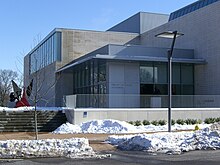
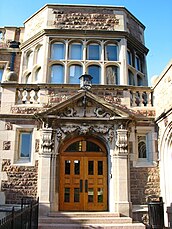






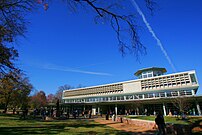







![Peter Sarsgaard, Award-winning actor[227]](http://upload.wikimedia.org/wikipedia/commons/thumb/e/e0/Sarsgaard_at_WUSTL_2007.jpg/84px-Sarsgaard_at_WUSTL_2007.jpg)
![Harold Ramis, Actor/director, Ghostbusters, Caddyshack, Animal House, National Lampoon's Vacation (film series))[228]](http://upload.wikimedia.org/wikipedia/commons/thumb/4/40/HaroldRamisOct2009.jpg/112px-HaroldRamisOct2009.jpg)
![Tennessee Williams, 20th-century Playwright of American drama[221][222]](http://upload.wikimedia.org/wikipedia/commons/thumb/7/78/Tennessee_Williams_NYWTS.jpg/111px-Tennessee_Williams_NYWTS.jpg)
![Robert Culp, Actor and screenwriter[229]](http://upload.wikimedia.org/wikipedia/commons/thumb/3/32/Robert_Culp_1965.JPG/100px-Robert_Culp_1965.JPG)
![Robert Guillaume, Actor (Soap, The Lion King, Guys and Dolls, The Phantom of the Opera)[230]](http://upload.wikimedia.org/wikipedia/commons/thumb/1/1d/Robert_Guillaume_SOAP_1977_%28cropped%29.JPG/94px-Robert_Guillaume_SOAP_1977_%28cropped%29.JPG)
![Kristin Bauer van Straten, Actress (Once Upon a Time,True Blood, Seinfeld)[231]](http://upload.wikimedia.org/wikipedia/commons/thumb/5/59/Kristin_Bauer_van_Straten_20121201_Toulouse_Game_Show_3.jpg/83px-Kristin_Bauer_van_Straten_20121201_Toulouse_Game_Show_3.jpg)
![Andrew McCabe, Former deputy director of the FBI[232]](http://upload.wikimedia.org/wikipedia/commons/thumb/7/79/Andrew_McCabe_official_portrait.jpg/100px-Andrew_McCabe_official_portrait.jpg)
![William H. Webster, Only person to have served as director of the Federal Bureau of Investigation and director of Central Intelligence[233][234]](http://upload.wikimedia.org/wikipedia/commons/thumb/5/58/William_H._Webster_2016.jpg/88px-William_H._Webster_2016.jpg)
![Pepper Schwartz, Sexologist and sociologist[235]](http://upload.wikimedia.org/wikipedia/commons/thumb/1/1a/Pepper_Schwartz_at_TEDx_Rainier.jpg/125px-Pepper_Schwartz_at_TEDx_Rainier.jpg)
![Rochelle Walensky, 19th Director of the Centers for Disease Control and Prevention[236][237]](http://upload.wikimedia.org/wikipedia/commons/thumb/b/b9/Rochelle_Walensky%2C_CDC_Director_%28cropped%29.jpg/100px-Rochelle_Walensky%2C_CDC_Director_%28cropped%29.jpg)
![Clark Clifford, Political adviser to presidents Harry S. Truman, John F. Kennedy, Lyndon B. Johnson, and Jimmy Carter[238][239]](http://upload.wikimedia.org/wikipedia/commons/thumb/8/80/Clark_Clifford_photo_portrait.jpg/100px-Clark_Clifford_photo_portrait.jpg)
![J. C. R. Licklider, Pioneer in artificial intelligence and the Internet[240]](http://upload.wikimedia.org/wikipedia/commons/thumb/6/66/J._C._R._Licklider.jpg/87px-J._C._R._Licklider.jpg)
![Quinton Lucas, Mayor of Kansas City, Missouri[241][242]](http://upload.wikimedia.org/wikipedia/commons/thumb/b/b3/Quinton_Lucas_at_Downtown_Airport_Renaming_2_%286717577%29_%28cropped%29_%28cropped%29.jpg/98px-Quinton_Lucas_at_Downtown_Airport_Renaming_2_%286717577%29_%28cropped%29_%28cropped%29.jpg)

![Dave Garroway, Founding host and anchor of NBC's Today[244]](http://upload.wikimedia.org/wikipedia/commons/thumb/7/78/Dave_garroway_publicity_photo_1950s.JPG/103px-Dave_garroway_publicity_photo_1950s.JPG)
![Jim McKelvey, co-founder and director of Block, Inc[245]](http://upload.wikimedia.org/wikipedia/commons/thumb/f/f4/Jim_Studio_Headshow.jpeg/78px-Jim_Studio_Headshow.jpeg)
![Fannie Hurst, Novelist[246]](http://upload.wikimedia.org/wikipedia/commons/thumb/3/32/Fannie_Hurst%2C_Kandeler_Photo.jpg/91px-Fannie_Hurst%2C_Kandeler_Photo.jpg)

![Leana Wen, Former President of Planned Parenthood[248]](http://upload.wikimedia.org/wikipedia/commons/thumb/b/bd/Dr_Leana_Wen_Jan_2013.jpg/83px-Dr_Leana_Wen_Jan_2013.jpg)
![Joe Madison, Radio talk-show host on SiriusXM Urban View[249]](http://upload.wikimedia.org/wikipedia/commons/thumb/b/bd/Joe_Madison_2019.jpg/107px-Joe_Madison_2019.jpg)
![Scott Hadland, Chief of the Division of Adolescent and Young Adult Medicine at Harvard Medical School[250]](http://upload.wikimedia.org/wikipedia/commons/thumb/1/18/Dr._Scott_Hadland.jpg/90px-Dr._Scott_Hadland.jpg)
![Stephanie D. Davis, Judge of the United States Court of Appeals for the Sixth Circuit[247][251]](http://upload.wikimedia.org/wikipedia/commons/thumb/5/55/Stephanie_Davis_%28Judge%29_%28cropped%29.jpg/102px-Stephanie_Davis_%28Judge%29_%28cropped%29.jpg)
![Steven Sater, Broadway lyricist and playwright (Spring Awakening)[252]](http://upload.wikimedia.org/wikipedia/commons/thumb/2/2a/Steven_Sater.jpg/94px-Steven_Sater.jpg)
![Andrea Palm, United States Deputy Secretary of Health and Human Services[253]](http://upload.wikimedia.org/wikipedia/commons/thumb/9/9f/Andrea_Palm%2C_Deputy_Secretary_of_Health_and_Human_Services.jpg/100px-Andrea_Palm%2C_Deputy_Secretary_of_Health_and_Human_Services.jpg)
![Buckminster Fuller, Systems theorist, author, designer, inventor, and futurist[271]](http://upload.wikimedia.org/wikipedia/commons/thumb/c/cd/BuckminsterFuller_cropped.jpg/95px-BuckminsterFuller_cropped.jpg)
![Thomas Eagleton, United States Senator from Missouri[272]](http://upload.wikimedia.org/wikipedia/commons/thumb/8/80/Thomas_F._Eagleton.jpg/82px-Thomas_F._Eagleton.jpg)
![Arthur Holly Compton, Discoverer of the Compton effect[273]](http://upload.wikimedia.org/wikipedia/commons/thumb/c/c0/Arthur_Compton_1927.jpg/93px-Arthur_Compton_1927.jpg)
![Luther Terry, Ninth Surgeon General of the United States who is best known for his warnings against the dangers and the impact of tobacco use on health[274]](http://upload.wikimedia.org/wikipedia/commons/thumb/d/db/Luther_Terry_photo_portrait_as_surgeon_general.jpg/114px-Luther_Terry_photo_portrait_as_surgeon_general.jpg)
![Rita Levi-Montalcini, Neurologist and Nobel laurete for the discovery of nerve growth factor[275]](http://upload.wikimedia.org/wikipedia/commons/thumb/9/92/Rita_Levi_Montalcini.jpg/94px-Rita_Levi_Montalcini.jpg)
![Joseph Erlanger, known for his contributions to the field of neuroscience[276]](http://upload.wikimedia.org/wikipedia/commons/thumb/c/c5/Joseph_Erlanger._Photograph_by_Esselte._Wellcome_V0026334.jpg/87px-Joseph_Erlanger._Photograph_by_Esselte._Wellcome_V0026334.jpg)
![Gerty Cori, First woman to be awarded the Nobel Prize in Physiology or Medicine[277]](http://upload.wikimedia.org/wikipedia/commons/thumb/d/d6/Gerty_Theresa_Cori.jpg/88px-Gerty_Theresa_Cori.jpg)
![Peter Mutharika, Former President of Malawi[278]](http://upload.wikimedia.org/wikipedia/commons/thumb/1/16/Arthur_Peter_Mutharika_2014_%28cropped%29.jpg/87px-Arthur_Peter_Mutharika_2014_%28cropped%29.jpg)
![Douglass North, Nobel Laureate Economist[279]](http://upload.wikimedia.org/wikipedia/commons/thumb/2/2c/Douglass_North.jpg/87px-Douglass_North.jpg)
![Bruce H. Mann, American legal scholar and husband of U.S. Senator Elizabeth Warren[280]](http://upload.wikimedia.org/wikipedia/commons/thumb/7/78/Bruce_Mann_-_The_Harvard_Crimson_%28cropped_and_edited%29.jpg/94px-Bruce_Mann_-_The_Harvard_Crimson_%28cropped_and_edited%29.jpg)
![Wiley Rutledge, Associate Justice of the Supreme Court of the United States[281]](http://upload.wikimedia.org/wikipedia/commons/thumb/6/6e/Wiley_Rutledge_portrait_by_Harold_M._Brett.jpg/97px-Wiley_Rutledge_portrait_by_Harold_M._Brett.jpg)
![Fumihiko Maki, United Nations' new building architect[282]](http://upload.wikimedia.org/wikipedia/commons/thumb/c/cf/Fumihiko_Maki_2010_alt.jpg/125px-Fumihiko_Maki_2010_alt.jpg)
![Barry Commoner, Leading ecologist and a founder of the modern environmental movement[283][284]](http://upload.wikimedia.org/wikipedia/commons/thumb/2/2a/Barry_Commoner%2C_politician-environmentalist_author.jpg/105px-Barry_Commoner%2C_politician-environmentalist_author.jpg)
![Ian Bogost, Game Studies scholar and video game designer[285]](http://upload.wikimedia.org/wikipedia/commons/thumb/e/e0/Ibogost_joystick_color_2.jpg/83px-Ibogost_joystick_color_2.jpg)
![Roger Nash Baldwin, co-founder and first executive director of the American Civil Liberties Union[286]](http://upload.wikimedia.org/wikipedia/commons/thumb/2/2a/Roger_Nash_Baldwin.jpg/99px-Roger_Nash_Baldwin.jpg)
![Alfred Hershey, Nobel Laureate bacteriologist known for the Hershey–Chase experiment[287]](http://upload.wikimedia.org/wikipedia/commons/thumb/9/9f/Alfred_Hershey.jpg/86px-Alfred_Hershey.jpg)
![Roy Vagelos, chairman and CEO of Merck & Co.[288]](http://upload.wikimedia.org/wikipedia/commons/thumb/a/a9/P._Roy_Vagelos_JPS_2005_03_10_crop.TIF/lossy-page1-125px-P._Roy_Vagelos_JPS_2005_03_10_crop.TIF.jpg)
![E.T. Jaynes, Theoretical physicist and statistician[289]](http://upload.wikimedia.org/wikipedia/commons/thumb/b/b0/ETJaynes1.jpg/100px-ETJaynes1.jpg)
![Mona Van Duyn, United States Poet Laureate[290]](http://upload.wikimedia.org/wikipedia/commons/thumb/7/79/Mona_Van_Duyn.jpg/113px-Mona_Van_Duyn.jpg)
![Wesley A. Clark, Credited for designing the first modern personal computer[291]](http://upload.wikimedia.org/wikipedia/commons/thumb/5/58/Wesley_A_Clark_2002.jpg/93px-Wesley_A_Clark_2002.jpg)
![Mary Jo Bang, Guggenheim Fellow (2004)[292]](http://upload.wikimedia.org/wikipedia/commons/thumb/d/db/Mary_Jo_Bang_2015.jpg/83px-Mary_Jo_Bang_2015.jpg)
![Lauren Ackerman, Championed the subspecialty of surgical pathology[293]](http://upload.wikimedia.org/wikipedia/en/thumb/2/23/Lackerman4.jpg/94px-Lackerman4.jpg)
![Henry Smith Pritchett, Head of the Carnegie Foundation for the Advancement of Teaching and 5th President of MIT[294]](http://upload.wikimedia.org/wikipedia/commons/thumb/9/90/Pritchett_5455605787_c74a68412d_o.jpg/78px-Pritchett_5455605787_c74a68412d_o.jpg)
![Barbara Schaal, First woman to be elected vice president of the National Academy of Sciences[295]](http://upload.wikimedia.org/wikipedia/commons/thumb/c/c1/Barbara_Schaal.jpg/110px-Barbara_Schaal.jpg)
